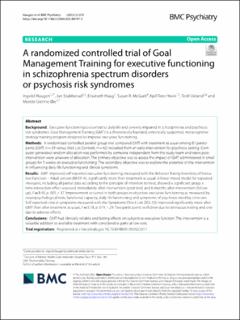| dc.contributor.author | Haugen, Ingvild | |
| dc.contributor.author | Stubberud, Jan Egil | |
| dc.contributor.author | Haug, Elisabeth | |
| dc.contributor.author | McGurk, Susan R. | |
| dc.contributor.author | Hovik, Kjell Tore | |
| dc.contributor.author | Ueland, Torill | |
| dc.contributor.author | Øie, Merete Glenne | |
| dc.date.accessioned | 2023-08-11T13:39:26Z | |
| dc.date.available | 2023-08-11T13:39:26Z | |
| dc.date.created | 2022-08-12T10:15:50Z | |
| dc.date.issued | 2022 | |
| dc.identifier.citation | BMC Psychiatry. 2022, 22 (1), . | en_US |
| dc.identifier.issn | 1471-244X | |
| dc.identifier.uri | https://hdl.handle.net/11250/3083637 | |
| dc.description.abstract | Background Executive functioning is essential to daily life and severely impaired in schizophrenia and psychosis risk syndromes. Goal Management Training (GMT) is a theoretically founded, empirically supported, metacognitive strategy training program designed to improve executive functioning. Methods A randomized controlled parallel group trial compared GMT with treatment as usual among 81 participants (GMT, n = 39 versus Wait List Controls, n = 42) recruited from an early intervention for psychosis setting. Computer generated random allocation was performed by someone independent from the study team and raters post-intervention were unaware of allocation. The primary objective was to assess the impact of GMT administered in small groups for 5 weeks on executive functioning. The secondary objective was to explore the potential of the intervention in influencing daily life functioning and clinical symptoms. Results GMT improved self-reported executive functioning, measured with the Behavior Rating Inventory of Executive Function – Adult version (BRIEF-A), significantly more than treatment as usual. A linear mixed model for repeated measures, including all partial data according to the principle of intention to treat, showed a significant group x time interaction effect assessed immediately after intervention (post-test) and 6 months after intervention (follow-up), F = 8.40, p .005, r .37. Improvement occurred in both groups in objective executive functioning as measured by neuropsychological tests, functional capacity, daily life functioning and symptoms of psychosis rated by clinicians. Self-reported clinical symptoms measured with the Symptoms Check List (SCL-10) improved significantly more after GMT than after treatment as usual, F = 5.78, p .019, r .29. Two participants withdrew due to strenuous testing and one due to adverse effects. Conclusions GMT had clinically reliable and lasting effects on subjective executive function. The intervention is a valuable addition to available treatment with considerable gains at low cost. Trial registration Registered at clinicaltrials.gov NCT03048695 09/02/2017. | en_US |
| dc.description.sponsorship | The work was supported by the South-Eastern Norway Health Authority
(grant number 2017012); Innlandet Hospital Trust (grant number 150602) and
University of Oslo (grant number 353139). | en_US |
| dc.language.iso | eng | en_US |
| dc.publisher | BMC | en_US |
| dc.relation.uri | https://bmcpsychiatry.biomedcentral.com/articles/10.1186/s12888-022-04197-3 | |
| dc.rights | Navngivelse 4.0 Internasjonal | * |
| dc.rights.uri | http://creativecommons.org/licenses/by/4.0/deed.no | * |
| dc.subject | Cognitive impairment; | en_US |
| dc.subject | Cognitive remediation; | en_US |
| dc.subject | Early intervention; | en_US |
| dc.subject | Executive function; | en_US |
| dc.subject | Psychosis; | en_US |
| dc.subject | Real-world function. | en_US |
| dc.title | A randomized controlled trial of Goal Management Training for executive functioning in schizophrenia spectrum disorders or psychosis risk syndromes | en_US |
| dc.title.alternative | A randomized controlled trial of Goal Management Training for executive functioning in schizophrenia spectrum disorders or psychosis risk syndromes | en_US |
| dc.type | Peer reviewed | en_US |
| dc.type | Journal article | en_US |
| dc.description.version | publishedVersion | en_US |
| dc.rights.holder | © The Author(s) 2022. Open Access This article is licensed under a Creative Commons Attribution 4.0 International License, which permits use, sharing, adaptation, distribution and reproduction in any medium or format, as long as you give appropriate credit to the original author(s) and the source, provide a link to the Creative Commons licence, and indicate if changes were made. The images or other third party material in this article are included in the article’s Creative Commons licence, unless indicated otherwise in a credit line to the material. If material is not included in the article’s Creative Commons licence and your intended use is not permitted by statutory regulation or exceeds the permitted use, you will need to obtain permission directly from the copyright holder. To view a copy of this licence, visit http://creativecommons.org/licenses/by/4.0/. The Creative Commons Public Domain Dedication waiver (http://creativeco mmons.org/publicdomain/zero/1.0/) applies to the data made available in this article, unless otherwise stated in a credit line to the data. | en_US |
| dc.source.pagenumber | 17 | en_US |
| dc.source.volume | 22 | en_US |
| dc.source.journal | BMC Psychiatry | en_US |
| dc.source.issue | 1 | en_US |
| dc.identifier.doi | 10.1186/s12888-022-04197-3 | |
| dc.identifier.cristin | 2042608 | |
| dc.relation.project | Universitetet i Oslo: 353139 | en_US |
| dc.relation.project | Helse Sør-Øst RHF: 2017012 | en_US |
| dc.relation.project | Sykehuset Innlandet HF: 150602 | en_US |
| cristin.ispublished | true | |
| cristin.fulltext | original | |
| cristin.qualitycode | 2 | |

